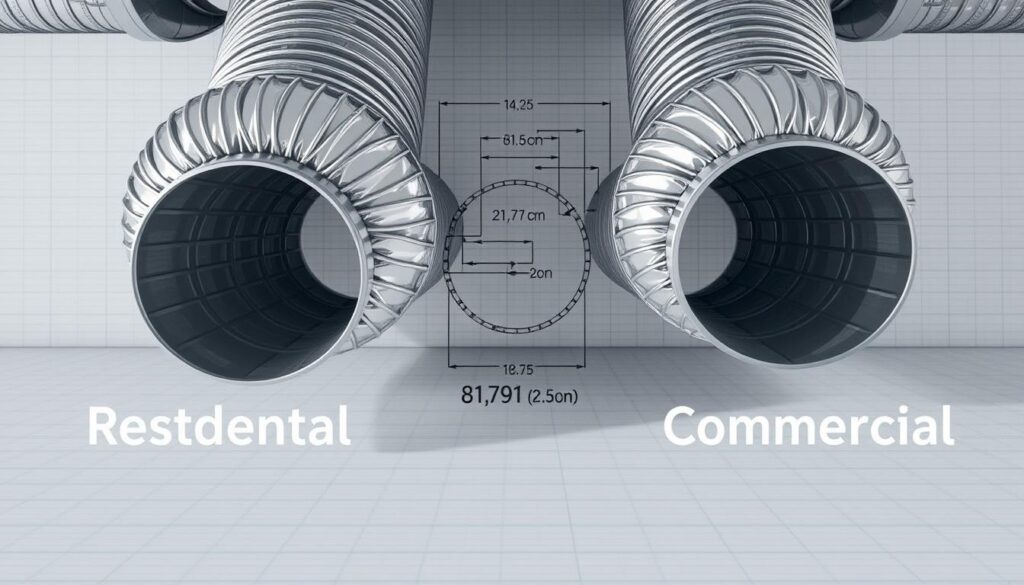Affiliate Disclosure
HVAC Guide Guys is a participant in the Amazon Services LLC Associates Program, an affiliate advertising program designed to provide a means for sites to earn advertising fees by advertising and linking to Amazon.
How Wide Are HVAC Ducts? Did you know the width of your HVAC ducts affects your home’s comfort and energy use? Choosing the right size isn’t just about measuring. It’s about creating the perfect climate for your home.

Knowing how wide HVAC ducts should be is key to your home’s heating and cooling. Every inch counts for air flow, energy use, and system performance.
HVAC experts say the right duct size can change your home’s comfort. Whether you’re building a new home or updating your system, knowing the right size saves money. It also prevents heating and cooling problems.
Key Takeaways
- Proper duct sizing directly impacts system efficiency
- Incorrect duct width can lead to increased energy costs
- HVAC duct dimensions vary based on home size and layout
- Professional assessment ensures optimal duct sizing
- Duct width affects overall air quality and comfort
Table of Contents
Understanding HVAC Duct Sizing Basics
HVAC duct sizing is key to a comfy and energy-saving home. The right size makes a big difference in comfort and bills. Knowing how to size ducts helps you choose the best for your home.
When sizing HVAC ducts, consider a few important things. These affect how well air moves and how comfortable your home is:
- Calculating the correct airflow volume
- Matching duct size to your HVAC system’s capacity
- Considering your home’s unique layout and square footage
Key Components of Duct Systems
An HVAC duct system has several important parts. They work together to move air around your home:
- Supply ducts: Deliver conditioned air to different rooms
- Return ducts: Collect air to be recirculated
- Registers and grilles
- Vent connections
Why Proper Duct Sizing Matters
Wrong duct sizes cause big problems. Too small, and your system works too hard and costs more. Too big, and air moves poorly, hurting system performance.
Common Duct Materials and Their Impact
Duct materials play a big role in sizing and efficiency:
- Sheet metal: Durable and long-lasting
- Flexible ducts: Easy to install in tight spaces
- Fiberglass-lined ducts: Provide additional insulation
Choosing the right duct material and size can improve your home’s energy efficiency by up to 20%.
Explore Our HVAC Shop
Looking for top-rated HVAC tools, parts, and accessories? Visit our shop and find the perfect solution for your needs.
Visit the ShopHow Wide Are HVAC Ducts: Standard Dimensions Guide
Knowing the standard sizes of HVAC ducts is key for a good heating and cooling system. The width of your HVAC ducts is important for even air flow in your home or business.
At home, HVAC ducts are usually between 4 to 18 inches wide. Smaller homes need narrower ducts, while bigger homes need wider ones for better air flow.
| Duct Type | Typical Width Range | Common Applications |
|---|---|---|
| Rectangular Ducts | 4″ – 24″ | Residential and light commercial spaces |
| Round Ducts | 6″ – 36″ | Large commercial buildings, industrial settings |
| Flexible Ducts | 4″ – 16″ | Tight spaces, complex routing |
Your HVAC duct width depends on a few important things:
- Square footage of the space
- Number of rooms
- Ceiling height
- Building insulation
Professional HVAC contractors use special math to find the right duct sizes for you. They look at airflow needs, system efficiency, and your building’s special features to suggest the best duct width.
Pro Tip: Always talk to a certified HVAC pro to get the right duct sizing for the best comfort and energy savings.
Explore Our HVAC Shop
Looking for top-rated HVAC tools, parts, and accessories? Visit our shop and find the perfect solution for your needs.
Visit the ShopFactors Affecting HVAC Duct Width Selection
Choosing the right HVAC duct width is key for comfort and saving energy. Several factors affect your duct size choices. Each one is important for your HVAC system’s best performance.
When picking the best HVAC duct width, think about a few important things. These elements affect how well your home heats and cools.
Square Footage Considerations
Your home’s size affects duct size needs. Bigger homes need wider ducts for better air flow. HVAC pros use a formula that looks at:
- Total living area square footage
- Number of rooms
- Ceiling height
- Insulation quality
Airflow Requirements
Measuring airflow in cubic feet per minute (CFM) is key for duct size. The right size ensures air moves well in your home.
| Home Size (sq ft) | Recommended CFM | Typical Duct Width |
|---|---|---|
| 1,000-1,500 | 400-600 CFM | 8-10 inches |
| 1,500-2,500 | 600-900 CFM | 10-14 inches |
| 2,500-3,500 | 900-1,200 CFM | 14-16 inches |
Building Layout Impact
Your home’s design greatly affects duct width choice. Things like multi-story homes, room layout, and duct paths need special thought. This ensures air flows well.
Pro tip: Always get a professional HVAC tech to size your ducts right for your home’s layout.
Calculating the Perfect Duct Size for Your Space
Finding the right HVAC duct size is key for comfort and saving energy. Your home’s layout affects the duct size you need. To figure out the right width, you must consider several important factors.
To start, you need to look at a few key measurements:
- Total square footage of your living space
- Airflow needs for each room
- Details of your heating and cooling system
- How your home is laid out and designed
Experts use special methods to find the exact duct size. They use complex formulas that take into account:
- The amount of air moved in cubic feet per minute (CFM)
- The pressure needed for air flow
- The loss of air pressure in the ducts
- The speed of air moving through the ducts
Pro tip: While you can try to figure it out yourself, getting a pro’s help is best. They can do detailed measurements for your home’s unique layout and air flow needs.
Getting the duct size right is not just about the width. It’s about making sure air flows well in your home.
Wrong duct size can cause big problems. It can make your energy use worse, your home’s temperature uneven, and your bills higher. By taking the time to measure right, you’ll make your home more comfortable and save money.
Explore Our HVAC Shop
Looking for top-rated HVAC tools, parts, and accessories? Visit our shop and find the perfect solution for your needs.
Visit the ShopCommon Problems with Incorrect Duct Sizing
Choosing the right HVAC duct size is key to your home’s comfort and energy use. If the size is off, it can mess up your heating and cooling system.
Not getting the duct size right can lead to big problems. These issues can affect how well your home works.
Energy Efficiency Challenges
Wrong duct sizes can really up your energy use. This makes your HVAC system work too hard, causing:
- Higher electricity bills
- Increased system wear and tear
- Reduced overall system lifespan
Airflow Distribution Problems
Bad duct sizes mess with airflow. This can lead to:
- Uneven room temperatures
- Weak air circulation
- Hot or cold spots throughout your home
System Performance Impact
Wrong duct sizes hurt your system’s performance. You might see:
| Problem Area | Potential Consequences |
|---|---|
| Undersized Ducts | Increased noise, reduced airflow, higher energy consumption |
| Oversized Ducts | Poor air distribution, inefficient cooling/heating, system strain |
To dodge these problems, talk to HVAC pros. They can figure out the right duct size for your home. They’ll suggest the best size for top performance.
Residential vs Commercial HVAC Duct Dimensions

It’s important to know the difference between residential and commercial HVAC duct sizes. Both types aim to keep spaces comfortable, but they need different sizes. This is because of the size of the building and how much air it needs.
Residential HVAC systems have smaller ducts, usually between 4 to 12 inches wide. These sizes work well for homes and apartments. The size needed depends on a few things:
- Square footage of the living space
- Number of rooms
- Ceiling height
- Insulation quality
Commercial HVAC systems need bigger ducts. They handle more air in larger spaces like offices and factories.
| Building Type | Typical Duct Width Range | Air Volume Capacity |
|---|---|---|
| Residential Single-Family Home | 4-8 inches | 400-1000 CFM |
| Commercial Office | 12-36 inches | 2000-10000 CFM |
| Industrial Facility | 24-60 inches | 10000-50000 CFM |
Professional HVAC designers carefully calculate precise duct dimensions to ensure optimal airflow and energy efficiency for each unique space.
“Proper duct sizing is not a one-size-fits-all solution. Each building requires a customized approach.” – HVAC Engineering Professionals
Using Duct Calculators and Sizing Tools
Understanding hvac duct sizing can be tricky, but today’s tools make it simpler. Duct calculators are key for HVAC pros and homeowners wanting better system performance.
Experts use advanced calculators to find the best hvac duct size for each space. These tools ensure accurate measurements and good airflow in your system.
Understanding CFM Calculations
Cubic Feet per Minute (CFM) is vital in hvac duct sizing. It helps figure out:
- The air volume needed for different room sizes
- The right amount of ventilation
- How efficient your system can be
Friction Rate Considerations
Friction rates are key to duct performance. Important factors include:
- The type of duct material
- The duct’s internal surface smoothness
- The ductwork’s length and layout
Velocity Requirements
Airflow velocity is also critical in duct sizing. Each space needs a specific velocity to work best.
| Space Type | Recommended Velocity (FPM) | Efficiency Rating |
|---|---|---|
| Residential Home | 700-900 | High |
| Commercial Building | 1000-1200 | Maximum |
| Industrial Facility | 1200-1500 | Specialized |
Even with these tools, getting help from a pro HVAC technician is best for complex jobs or special buildings.
Explore Our HVAC Shop
Looking for top-rated HVAC tools, parts, and accessories? Visit our shop and find the perfect solution for your needs.
Visit the ShopProfessional Installation and Sizing Guidelines

Choosing the right professional for your HVAC duct installation is key. They know how to pick the right size for your system. It’s not just about measuring.
Professional HVAC technicians are experts in sizing your ducts for the best performance. They look at many things:
- Precise building measurements
- Airflow calculation requirements
- Specific room ventilation needs
- Structural layout considerations
“Accurate duct sizing is not just about dimensions, but about creating a balanced air distribution system,” says Mark Reynolds, HVAC Engineering Specialist.
Installers use special tools and complex math to find the best duct sizes. They avoid mistakes that can hurt your system’s performance.
Professional installation offers many benefits:
- Optimal energy efficiency
- Reduced long-term maintenance costs
- Improved indoor air quality
- Extended system lifespan
By choosing professional installation, your HVAC system will work better. You’ll save money and stay comfortable.
Signs Your Duct Size Needs Adjustment
Knowing how wide HVAC ducts should be is key for a comfy home. Your HVAC system might show signs it needs a duct size check. This is important for your home’s comfort.
Spotting duct size issues can prevent energy waste and make your home more comfortable. The right duct size is vital for your home’s heating and cooling.
- Uneven room temperatures across different areas
- Persistent high energy bills despite regular maintenance
- Loud whistling or banging sounds from air vents
- Frequent HVAC system cycling
- Reduced airflow from specific registers
These signs point to ductwork problems linked to the wrong size. Narrow ducts make air flow hard, leading to pressure issues and poor performance.
| Symptom | Potential Duct Size Issue |
|---|---|
| Hot/Cold Spots | Inadequate air distribution |
| High Energy Costs | Inefficient airflow resistance |
| Noisy Operation | Restricted air movement |
If you see many warning signs, get an HVAC expert’s help. They can check your ducts and suggest fixes. They might recommend new ducts or a full system update to get your system working right again.
Conclusion
Knowing about HVAC duct sizing is key for a comfy and efficient home. Your grasp of hvac duct dimensions greatly affects your system’s performance and energy use. The right sizing ensures air flows well in your space.
Choosing the correct duct width involves many factors. These include your home’s size, airflow needs, and layout. HVAC pros can guide you through these choices, making sure your system works best.
New HVAC tech is coming, with better designs and sizing methods. Keeping up with these changes and talking to experts helps you make smart choices. This ensures your home stays cool and comfy for years.
Learning about hvac duct sizing now can save you money and avoid future comfort problems. Your home’s comfort and energy efficiency rely on getting these details right.

